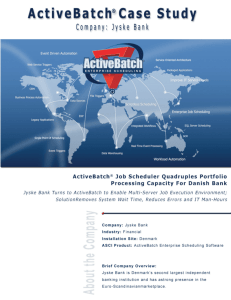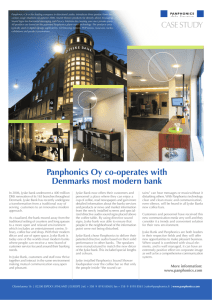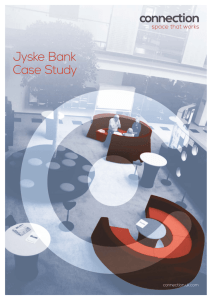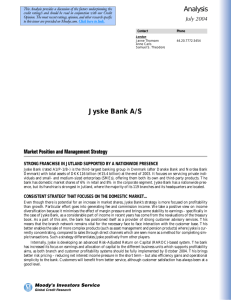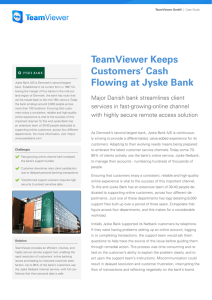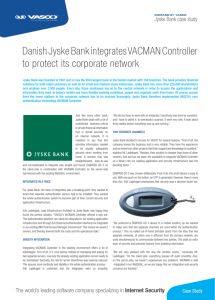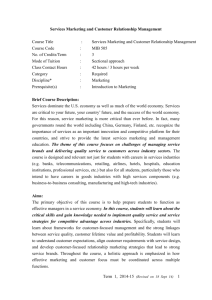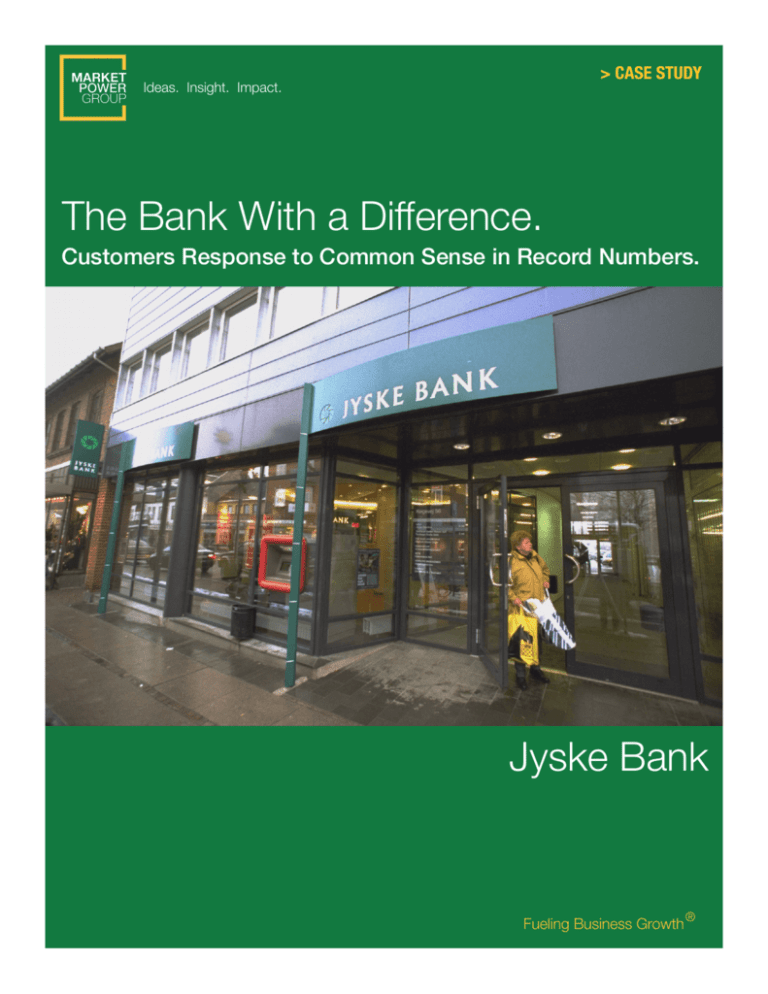
> CASE STUDY
Ideas. Insight. Impact.
The Bank With a Difference.
Customers Response to Common Sense in Record Numbers.!
Holt Cat
Jyske Bank
®
Fueling Business Growth
On a cold December evening,
twenty bank customers in
Kansas City discussed their
negative attitudes about the way
they were treated by their banks.
Little did they know that five
thousand miles away, a company
had already heard their
complaints and was doing
something to permanently alter
the relationship between a
banking institution and its
customers by understanding the
Power of the Heart.
There have been three generations of banks. The first
was the fortress bank, simply a safe place to keep
your money. Service was sparse because there was
minimal competition. Banks could set all the rules.
They could keep their own hours, closing at three
o’clock in the afternoon, for example. It mattered little
if the customer was inconvenienced; the bank’s job
was to protect the money, not try to grow it.
The second generation was the reluctant marketer
bank. In the 1980s, banking was deregulated in an
effort to spur com- petition, and it worked. At first,
bankers didn’t know how to compete except to offer
a free premium, like a toaster, if you opened a
checking account. But as competition increased, the
level of market segmentation and sophistication did
as well.
Today, the third generation is the differentiator bank.
We have witnessed so much consolidation that it is
hard to know the players without a program. But in
Denmark there’s a bank that is paying huge
dividends. In this case, three unlikely entities merged,
entities you wouldn’t normally combine: a bank, a
butik, and a bibliotek (bank, store, and library).
Jyske (pronounced Yeeska) Bank is headquartered
in Silkeborg, Denmark. With a population of only
forty-three thousand, the city is less than a tenth of
Kansas City. But the Customer CEO changes
introduced by Jyske over the past decade have
introduced a revolution of choice in the
conservative banking industry. Jyske Bank has
been intensely studied and its innovative ideas are
rippling across the globe. Jyske realized that it had
an opportunity to reinvent itself, even though the
business was doing well. But executives felt the
bigger risk was to rest on their laurels and do
nothing.
To set themselves apart, the bank created Jyske
Differences, which focused on four areas: people,
facilities, marketing, and customer counseling
tools. The bank collaborated with the Copenhagen
Institute for Future Studies, a social science think
tank, to explore emerging trends for customers. Jyske teams spent time in the field studying
Starbucks and Apple Stores, and observed
that they were making deep, emotional
connections to their customers. This was
unlike anything banks had ever done.
Customers also felt that personal financial
decisions were hard because the product
choices were often too abstract. People
needed more concrete and tangible ways to
understand the wide array of bank products
and services. Customer interviews found
that, to most people, banks were cold,
detached places that did little to understand
the needs of their customers.
The bank wrote a manifesto called Our
Foundations to publicly outline what Jyske
really stood for. This document sent a clear
message both internally and externally that
this bank was really different. Here’s just a
brief portion:
“Our core values are carved in stone. They
are common to us all and govern the way
we behave towards each other. In the eyes
of both customers and employees, our
values are what make us special.
Our values are:
• Common sense
• Being open and honest
• Being different and unpretentious
• Showing genuine interest and equal
respect
• Being efficient and persevering”
To get it right, Jyske knew that the bank and
its employees had to sincerely “demonstrate
insight and respect for other people.”
Employees were trained to provide the
customer with an “experience” like none
other. This meant supporting their
customers and helping them fulfill their
dreams. Some customers were recent
university graduates beginning new careers.
Others needed help maximizing savings as
they built their families. Some were working
toward a more secure retirement. The bank
The bank switched to using a team concept, with
specialists trained to help solve specific financial
problems and provide advice for every need.
Jyske started calling each branch a “shop.” Upon
entering a shop, you see a wide-open, well-lit store
that pulls you inside. You are greeted by a concierge
who directs you to the area you need. At the entry
you also see a large, ugly catfish, a whimsical icon for
Jyske since 1982. Instead of a teller’s window, you
find a MoneyBar for quick bank services. The
Market Square features banking products packaged
in boxes, similar to the way software is displayed at
computer stores. The boxes can be scanned—when
they are, a video pops up on a flat screen and
explains features and benefits. Every shop features
an “Oasis,” which looks like a library and has current
magazines and books about personal finance. And of
course there is the Jyske CoffeeBar. The bank wants
to have the world’s best coffee. Jyske customers
loved this mix of places. Shops became special
community gathering places.
The bank’s success with these changes has been
remarkable. Deposits and customers soared over the
past decade because Jyske successfully tapped into
the Power of the Heart by engaging customers with
empathy. It has created a culture and a place that
truly cater to what its customers need.
Portions of this article are adapted with permission from Customer CEO: How to Profit from the Power of Your Customers by Chuck Wall
(Bibliomotion, April 2013)..
Ideas. Insight. Impact.
Portions of this article are adapted with permission from
Customer CEO: How to Profit from the Power of Your
Customers by Chuck Wall (Bibliomotion, April 2013).
MarketPower Group LLC
512.358-9090
marketpowergroup.com
© 2013, All rights reserved.

